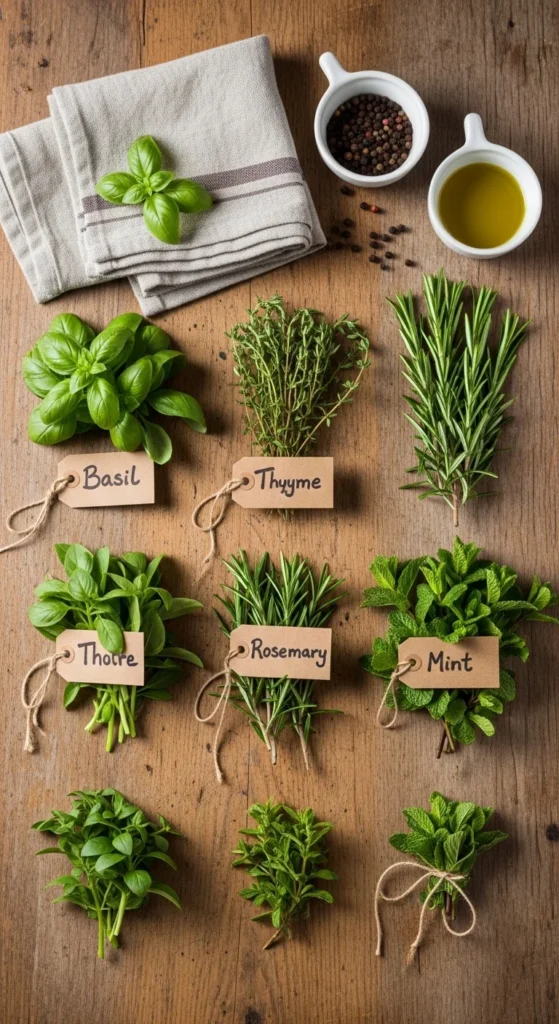There’s a magic trick in the kitchen that instantly makes food taste fresher, smell better, and look more vibrant — and it doesn’t require fancy ingredients or hours of cooking. The secret? Fresh herbs.
Whether you’re sprinkling basil on pasta, tossing mint into a salad, or finishing roasted veggies with parsley, herbs are like the final brushstroke on a masterpiece. They bring dishes to life with color, aroma, and depth that dried herbs just can’t match.

Why Fresh Herbs Make Such a Difference
Fresh herbs are more than just garnish — they add brightness and complexity that balance flavors and awaken your palate. Think of them as the “personality” of a dish: basil brings warmth, mint cools things down, rosemary adds depth, and cilantro adds freshness.
Here’s what makes them special:
- Aroma: Fresh herbs release essential oils that perfume your food as you cook.
- Flavor contrast: They cut through rich, heavy dishes with freshness.
- Color & presentation: A sprinkle of green instantly makes any meal look gourmet.
Simply put, fresh herbs turn “good” meals into memorable ones.
Step 1: Know Your Herbs
Not all herbs behave the same way. Some are delicate and best added at the end, while others can handle heat and develop deeper flavor when cooked.
Tender Herbs (Add at the End):
These lose their flavor if cooked too long.
- Basil: Sweet and peppery — perfect for pasta, pizza, and tomato dishes.
- Cilantro: Citrusy and bright — amazing in Mexican or Asian dishes.
- Parsley: Clean and mild — works with almost everything.
- Mint: Refreshing — great for salads, drinks, and desserts.
Sturdy Herbs (Cook Them In):
These herbs stand up to heat and infuse dishes over time.
- Rosemary: Earthy and piney — pairs beautifully with roasted meats and potatoes.
- Thyme: Subtle and savory — ideal for soups, stews, and roasted veggies.
- Sage: Warm and woodsy — wonderful in butter sauces and stuffing.
- Oregano: Bold and slightly bitter — a must for Mediterranean cooking.

Step 2: Prep Herbs the Right Way
Herbs are delicate, and how you handle them can make or break their flavor.
Washing & Drying
Rinse herbs under cool water to remove dirt, then gently pat them dry with paper towels or spin them in a salad spinner. Wet herbs can wilt quickly or make your dish soggy.
Chopping Techniques
- Use a sharp knife to avoid bruising leaves.
- For tender herbs like basil, tear by hand instead of chopping to keep their oils intact.
- For sturdier herbs like rosemary or thyme, strip the leaves from the stem before chopping.
Storing for Freshness
Wrap washed herbs loosely in a damp paper towel and store them in a resealable bag or jar in the fridge. They’ll stay fresh for up to a week — sometimes longer if you treat them right!
Step 3: Match Herbs with the Right Foods
Knowing which herbs complement which dishes is the key to confident cooking.
Perfect Pairings
- Basil + Tomatoes: A timeless duo — think caprese salads or marinara sauce.
- Rosemary + Chicken or Potatoes: Adds warmth and aroma to roasts.
- Cilantro + Lime: Brightens tacos, rice bowls, and stir-fries.
- Mint + Lemon: Refreshing in drinks, yogurt sauces, or fruit salads.
- Parsley + Garlic: The base of countless Mediterranean dishes.
Tip: Use one or two herbs per dish to let their flavors shine. Too many can make your meal taste muddled.

Step 4: Add Herbs at the Right Time
Timing is everything when it comes to using fresh herbs.
- For cooked dishes: Add sturdy herbs early so they can infuse their flavor. Save tender herbs for the last minute or sprinkle them on just before serving.
- For salads or cold dishes: Toss herbs in right before eating to keep them bright and crisp.
- For sauces and dressings: Whisk or blend herbs with oil and acid (like lemon juice or vinegar) for a fresh, fragrant kick.
Pro Tip
To make herbs last longer in hot dishes, add a touch of fat (like olive oil or butter). It helps preserve their essential oils and distributes flavor evenly.
Step 5: Use Herbs Beyond the Obvious
Herbs aren’t just for savory recipes — they can transform drinks, desserts, and snacks too!
Try these creative uses:
- Infused Water or Lemonade: Add basil, mint, or rosemary sprigs.
- Herb Butter: Mix softened butter with parsley, thyme, or chives for steaks or bread.
- Sweet Treats: Pair mint with chocolate or thyme with lemon desserts.
- Smoothies: Add a few mint or basil leaves for a refreshing twist.

Step 6: Don’t Waste the Stems
Here’s a chef’s secret: the stems of many herbs are packed with flavor too!
- Parsley, cilantro, and basil stems can be finely chopped and added to soups, sauces, or stocks.
- Woody stems like rosemary or thyme are perfect for flavoring roasted meats — just remove them before serving.
You’ll waste less and get even more flavor out of your herbs.
Final Thoughts
Fresh herbs are the simplest way to bring life to any meal — no fancy tools or gourmet ingredients required. Whether you’re topping off a pasta bowl with basil, stirring rosemary into roasted vegetables, or brightening a salad with mint, a few leaves can completely transform your dish.
So next time you cook, skip the shaker and grab a handful of something green. Your taste buds (and your dinner guests) will thank you.



Leave a Reply